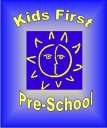|
Communication and language form the basis of a young child's learning. Children communicate through body language, taking turns, talking and interacting with other children and adults.
A child who communicates is able to participate more fully in the pre-school setting.
As young child, adults will often interpret their needs from their body language: Crying, smiling, and pointing. As their language develops, a child will be less dependent on actions, although body language is an important form of communication throughout life.
At Kids First, we like to form caring and close relationships with the children, so their need to develop communication and language are made easier.
In each of the six areas of learning we encourage the children to communicate their thoughts, ideas and feelings. Each day we share in talking about experiences, singing, action rhymes, songs and telling stories. We have music, cookery, grow seeds, paints, playdough, sand, water, construction toys, puzzles, dressing up, poems, miniature play, all activities which encourage a child to listen and communicate whilst gaining a sound learning.
Role-play is encouraged, as often a child will communicate easier with others whilst being part of an imaginary experience.
Books are always available for the children to look at, read and to borrow.
Literacy is encouraged through the sharing of books and telling stories, making greeting cards, labeling, naming their work and pencil skills.
Everyday situations provide opportunities for language, and a child who asks "why"? Will enhance their knowledge and improve their language.
"Learn through play"
|
